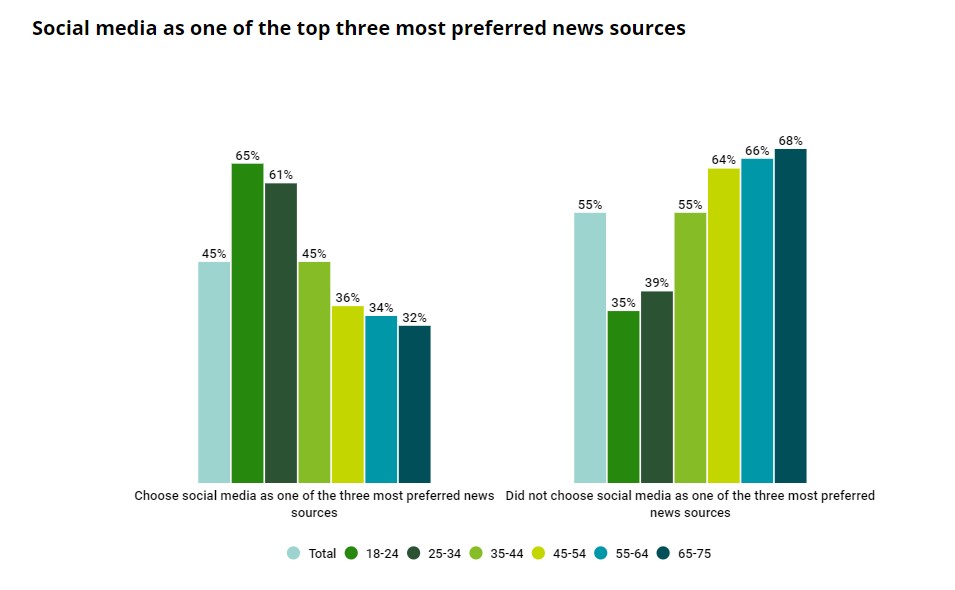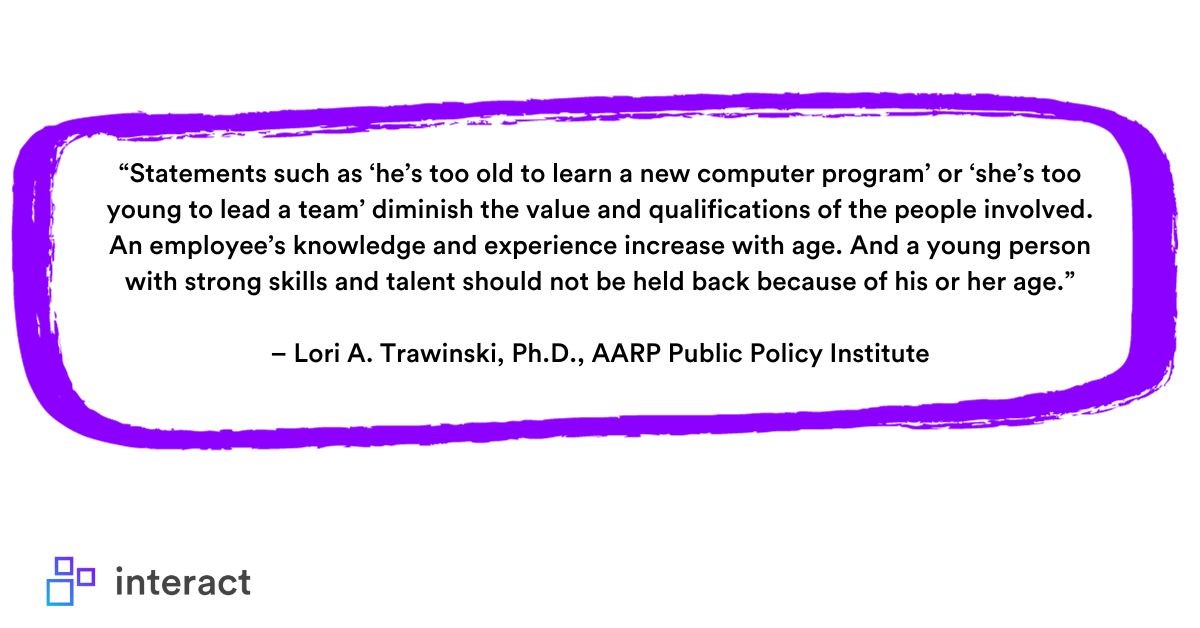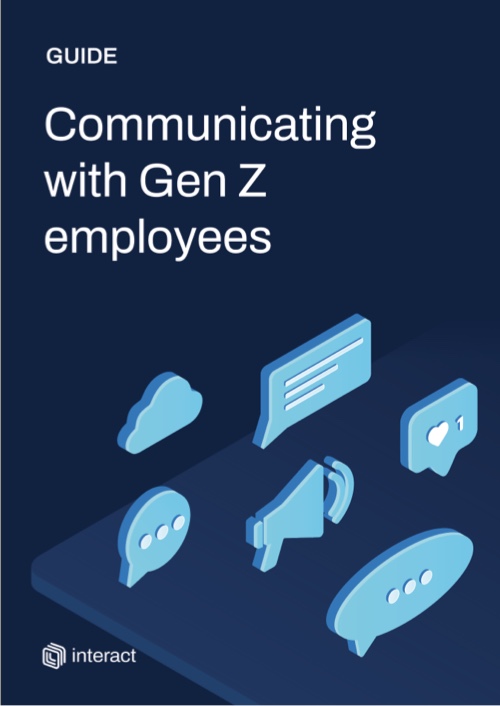Should you use the age of employees to improve the effectiveness of internal communications campaigns? Generational differences in the workplace are often seen as a barrier to effective communication but taking a balanced approach to age can drive culture and engagement. Here’s how.
You are not about to learn any new slang
This article isn’t a glossary of Generation Alpha lingo so your CEO can look hip. And capturing the attention of Gen Z isn’t as simple as putting your HR policy into TikTok. Intergenerational communication is complex and reducing people to stereotypes is bad practice.
However, age can be a useful driver of effective workplace communication.
There are five generations of people still working and research shows that there are broad differences in their interests and preferences.
Creating an internal communications strategy that engages everyone means being as alert to these differences as to location or role.
Based on that, this article outlines how to build a multichannel comms strategy that accounts for generational differences in the workplace. You can succeed by balancing push and pull, increasing intergenerational contact, and giving people more options—all without resorting to emojis or memes.
Age diversity is relevant for communicators, part one
A pillar of (top-down) internal communication is that effectiveness is measured by how widely a message is received and understood. Making communication more granular and personalized helps to increase how likely this is.
For example, when a hybrid workforce is dispersed across different locations, the communications team may create different messaging strands for retail stores and corporate offices. This ensures that all the relevant people will receive the messages pertinent to them, their role, and their location, through a combination of the intranet, email, digital signage, manager cascades, and more.
Location, role, and seniority are all great, but to create more granular and personalized communications, generational differences in the workplace can be an added factor that increases the chance of comms success.
Communicating with Gen Z employees
How should you begin to think about generational differences? You start by offering more choices.
Deloitte has identified distinct variations in the channels that different generations use to consume news. This is relevant because a lot of top-down internal communication takes the form of news too.

Source: Deloitte – Are younger generations moving away from traditional news sources?
Deloitte’s analysis shows that younger generations prefer social media over traditional news sources such as broadcast and print media. Older generations still rely on those sources for news.
The insight here, however, is not that organizational news should only take one form or another. The takeaway is comms preferences do vary but they are not exclusive. If you want to reach the widest possible audience, choice is key.
Offering people a blend of communications will be more effective than only sending an email or Slack message.
Age diversity is relevant for communicators, part two
Another pillar of internal communication is that it should be inclusive and engaging. To that end, professional communicators should cater to the needs of different groups.
There are good examples of this for neurodiverse communication and accessibility standards, but less for age.
Research by PwC found that only 8% of organizations include age within their Diversity, Equity, and Inclusion strategies. Caused by the unconscious bias of senior leaders and communicators, ageism – and comms that exclude generations – may in some cases result simply from key figures having the “privilege of being the right age”.
Although we may want to take the preferences of our audiences into account, when time and resources are limited, it’s not unusual to restrict efforts to those most comfortable to the creator.
And ageism is more than the exclusion of older people from the hiring process.
Communicating with Gen Z employees
During the rise of remote working in 2020-2021, many younger people living in house-sharing arrangements battled for space and internet bandwidth with roommates.
Inevitably, this was less of a problem for senior leaders with home offices, so company comms were more focused on their preferences and privileges.
For communicators to reach everyone in a way that also shows that inclusion is a top priority, meetings and other company communications should also be diverse enough that no one feels excluded.

Bridge generational differences with these comms strategies
If you want to create an age-diverse comms plan that engages more people, consider these ways to create a level playing field for everyone from Zoomers to Baby Boomers.
1. Research employee communication preferences
If you want to connect with people, avoid making assumptions without evidence.
You may already perform an annual (or more frequent) internal communications survey. And, although annual polls are useful for a broad view, they rarely get 100% engagement.
Using a combination of frequent, shorter pulse surveys, focus groups, manager feedback, and social listening can all deepen your understanding of what people want to hear about, how often they want to be contacted, and through which channels.
We’ve spoken a lot about age as an important factor, but it’s possible that you may not be able to easily access generational data.
Some HR teams store anonymized age data for the purposes of DE&I reporting, but this is not universal.
If you don’t have access to that information, adding a voluntary question about generational ranges to your internal communications surveys adds context to individual and group preferences. Generational age ranges are:
- The Silent Generation – born 1925-1945
- The Baby Boomer Generation – born 1946-1964
- Generation X – born 1965-1979
- Millennials – born 1980-1994
- Generation Z – born 1995-2012
2. Take a multichannel approach
If you’ve already researched your organization’s internal comms preferences, you’ll know that different employees (and groups) have different needs. It’s important to meet these through comms campaigns that use a range of channels.
Fortunately, whether employees want to receive all-company emails or prefer sticking to Slack, it’s now easier than ever for communicators to create a single source message on the intranet and set up instant alerts issued to email, digital signage, Teams, Slack, and more.
Communicating with Gen Z employees
By drawing everyone to a single source of information on your intranet, you can honor those generational differences in the workplace without having to set up a wide range of unmanageable channels that few people read.
Learn more about creating a multichannel communications strategy here.
Ultimately, incorporating a mix of push and pull approaches will help to broaden the reach of different internal messages.
3. Develop channels and content for different age groups
Channels aren’t the only thing that should be diverse in order to involve the various generations.
Again, it’s important not to assume that stereotypes are correct. There is no simple correlation between Generation X being interested in 401 (k) planning and Generation Z only favoring stories about professional development.
The important thing is balance. Focusing solely on one type of content may naturally reflect implicit biases and organizational norms, so rotating content that varies from celebrating success to highlighting CSR programs can help to make all generations feel valued.
If people haven’t indicated preferences in your research, some social listening in intranet forums or on relevant social media platforms may illustrate broad content themes to include.
Sign up for The Roundup newsletter for a weekly dose of workplace trends and news.
4. Focus on inclusive values
Organizational culture and company values don’t change frequently, but if you are going through a rebrand or restructuring, think about whether your vision and values are as diverse as your workforce.
Values that touch on customer-centricity or kindness, for example, may be a better fit for intergenerational harmony because they have universal appeal. Focusing solely on being an expert, however, may freeze out more junior people who are developing their careers and experience.
Universal values can become a rallying point that unites people and fosters interpersonal connection.
5. Increase intergenerational communication
Peer-to-peer communication is important for building strong ties and driving company culture. That’s less likely to happen though if generational differences at work allow people to hold ingrained biases.
Comms and HR professionals can all help to improve the connections between different age groups by:
- Creating opportunities for informal interaction: Coffee breaks, lunch-and-learns, and team-building activities allow employees to connect and break down barriers.
- Encouraging bilateral mentoring: This shouldn’t be a one-way process. Each generation has different skills and life experiences to teach others.
- The “manual of me” approach: Many teams now encourage employees to set out their own communicational preferences and learning styles. This clarity helps people to connect in an authentic and productive way.
Look beyond the date of birth
Our goal as communicators is to increase engagement and awareness. There are many strategic and technological tools to help us do this; age can be one of them.
Ultimately, we want to respect the differences between people without following unfounded assumptions about what they like or can easily access.
Create a greater choice of content and channels and you’ll drive engagement and foster inclusion.



